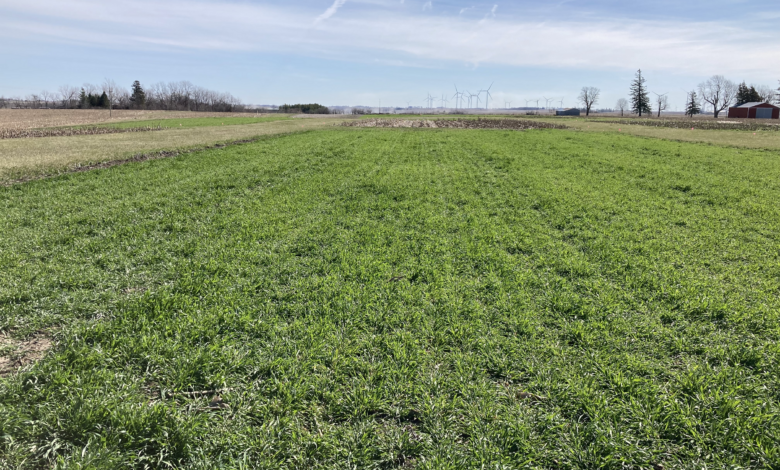Organic Agriculture Program Releases New Video Documenting Drone Use for Red Clover
Drone technology offers benefits for planting into wet field conditions

Seeding red clover this time of year is a good practice to establish a legume into a standing small grain crop, like rye. Ideally, seed is sown when the ground is frozen to allow frost heaving or the upward swelling of the soil during freezing conditions to work the seed into the soil. Even if you miss the freezing conditions, sowing in early spring will promote an ideal start for red clover growth.
It is crucial to seed early so that the red clover establishes before competing weeds germinate. The Iowa State University Organic Agriculture Program recently used a drone to frost-seed their red clover into fields of hybrid rye that were planted in October 2023. The drone was used instead of the normal practice of broadcasting or drilling the red clover into the standing rye.
A video of the planting process was recorded at Iowa State’s Neely-Kinyon Memorial Research and Demonstration Farm in Greenfield and is available on the Integrated Pest Management channel.
“The drone allowed us to get the seed in the field when the ground was too wet to use large equipment,” said Kathleen Delate, professor and extension organic specialist in horticulture and agronomy at Iowa State University.
The drone was flown by Precision Aerial Applications, Ankeny, and was a DJI Agras T40 with an 18.5-gallon tank attached for spreading the seed. The drone flew at 10 mph and seed was spread at a height of 16 ft. off the ground. The swath width of the drone is normally 25 ft. for seed spreading; however, windy conditions required narrowing the swath width to 18 ft. to provide better seed coverage over each area.
Red clover inter-seeded into winter rye or hybrid rye can supply nitrogen for a subsequent corn crop and help build soil quality. Research done in the Upper Midwest has shown average fertilizer replacement value of red clover for a subsequent corn crop is 50 to 120 pounds per acre. The goal for the hybrid rye/red clover mixture at the N-K Long-Term Agroecological Research (LTAR) site is to provide multiple years of high-quality forage and nitrogen provision to the subsequent corn crop in the rotation. Red clover also can mitigate erosion, suppress weeds and build soil organic matter. For spring wheat or oat plantings, red clover seed can be combined using a seed drill capable of simultaneously planting the small grain and red clover seed.
Hybrid rye is a relatively new crop in Iowa whose uses include animal feed, flour for baked goods or cooked as whole grain. Protein levels in hybrid rye range from 10% to 11%, compared to 8% to 9% in corn. The grain also contains high levels of lysine and phosphorus. Grain yields have been reported from 60 to 130 bushels per acre across the Midwest, which can be correlated with varietal differences along with varying temperature and rainfall.
An examination of the allelopathic properties of hybrid rye, specifically through root exudates, will demonstrate the powerful effect on helping mange weed populations. Corn, as a larger-seeded crop, avoids the allelopathy because the seed is planted deeper than smaller-seeded crops that may be affected. Iowa State will be sharing information on the economics of growing this new crop in combination with red clover.
For more information, contact Kathleen Delate at 515-294-7069 or kdelate@iastate.edu




